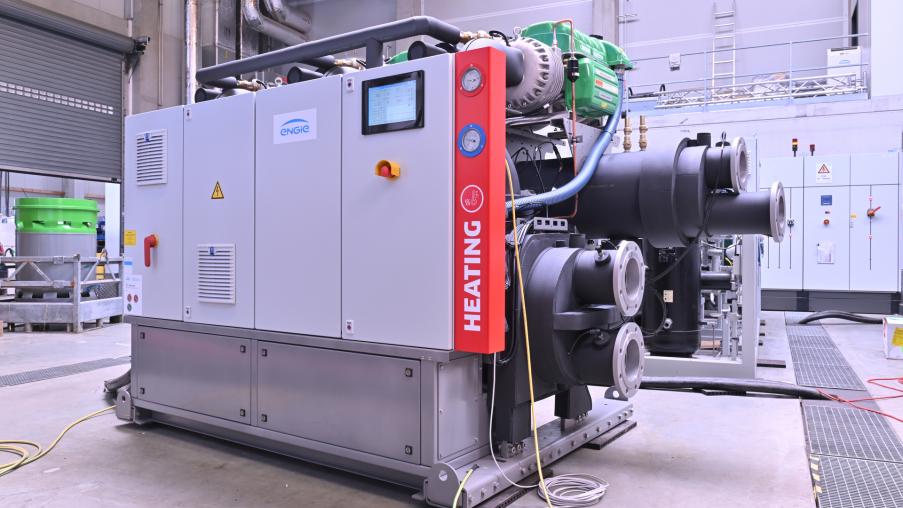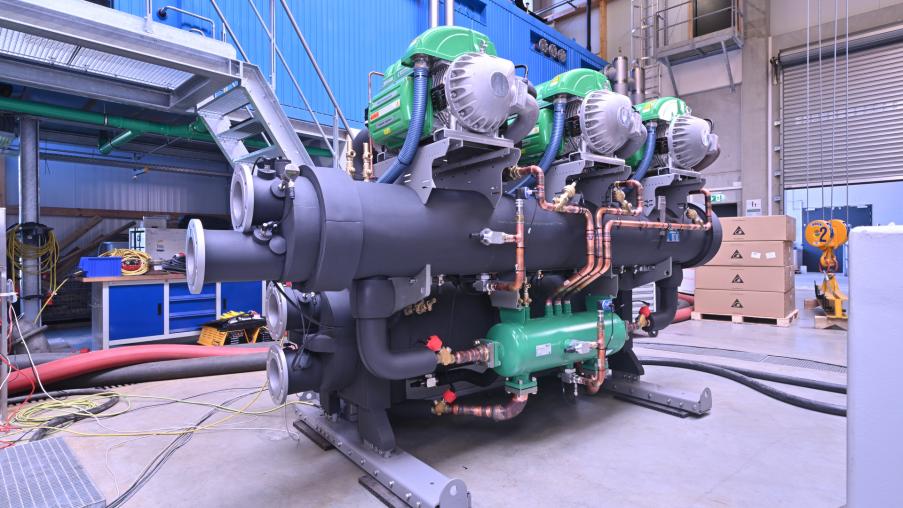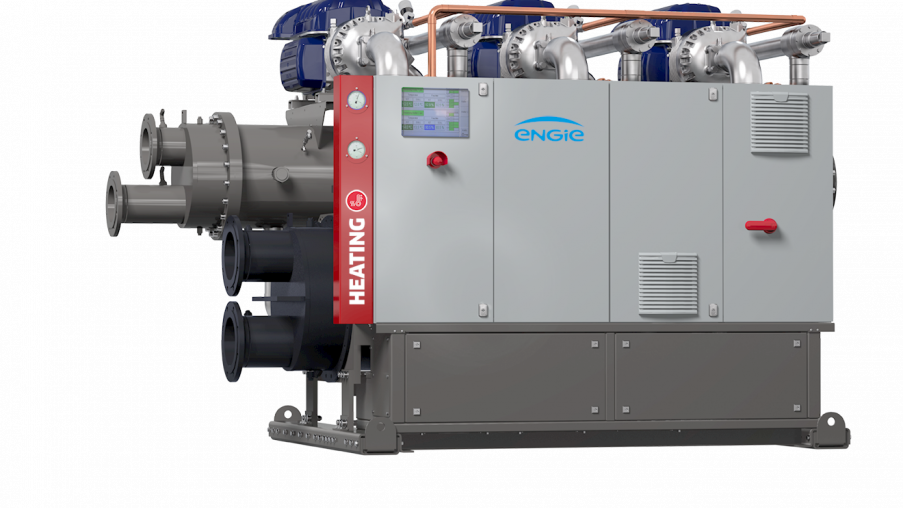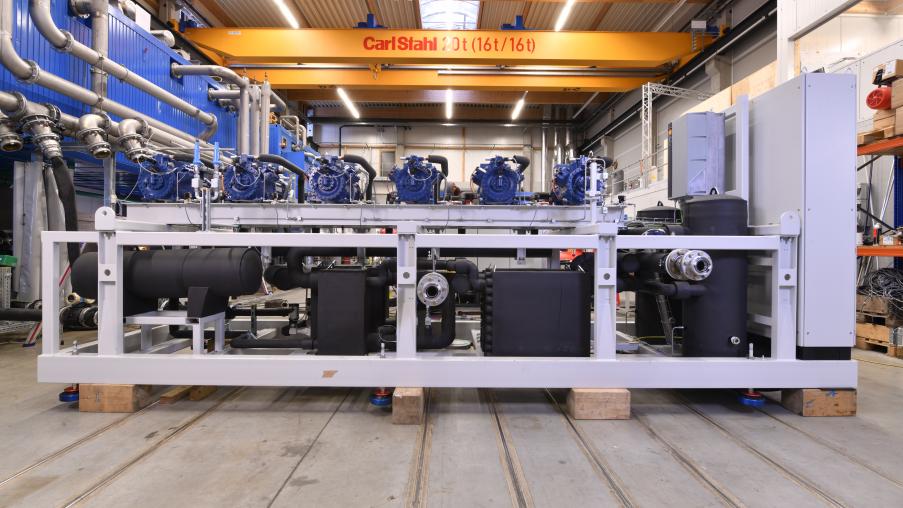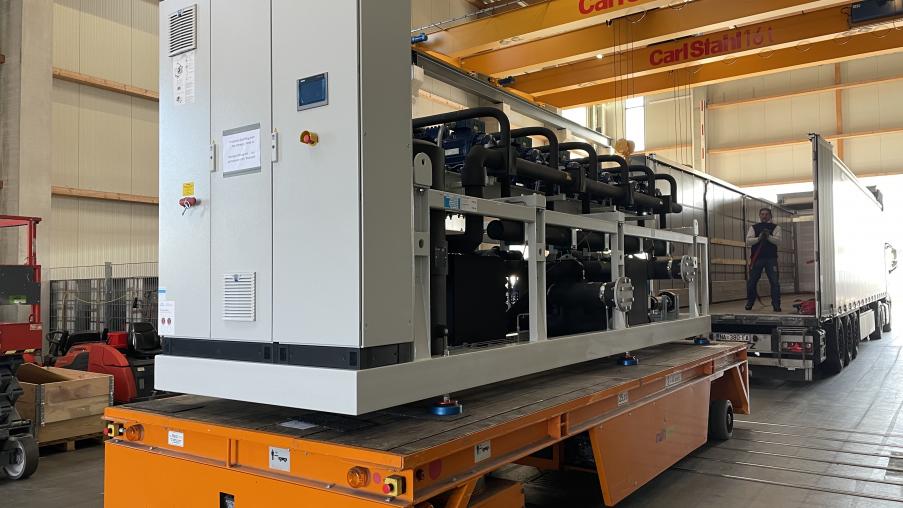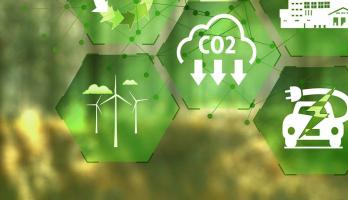
Mission: the future mastering the urban and municipal heating transition with a large heat pump
The heating transition starts in buildings. This means that cities and municipalities, with their large number of buildings, play a crucial role on the path to carbon neutrality. What’s the best way to structure the energy transition and heating transition as soon as possible and as successfully as possible? Large heat pumps such as the SPECTRUM Water and thermeco2 can make an important contribution to this endeavour.
There’s barely an issue that has a stronger hold on cities, municipalities and residential districts right now than the heating transition, and the need to permanently phase out fossil fuel sources such as oil and gas. What’s plain to see: there’s no energy transition without a heating transition. However, the current share of regenerative energy sources in the heating supply sector only totals around 17 per cent. For comparison: regenerative energies already account for more than 40 per cent in the electricity sector. It is therefore no wonder that the heating sector is often referred to as the ‘sleeping giant’ of the energy transition. In order to meet the federal government’s ambitious target of a 50 per cent share of renewables in the heating supply sector by 2030, a massive expansion of regenerative energies will be necessary over the next few years – and not only in the private sector, but in business, cities and municipalities as well. Driven by developments in the global geopolitical situation, all sectors are currently making major efforts to expedite the phase-out of fossil fuels from the energy mix – and to turn plans for a
Why we need to wake the sleeping giant that is the ‘heating transition’
The building heating sector in particular, which accounts for around 35 per cent of Germany’s current energy requirements and of which only one quarter is covered using regenerative energies, conceals a huge potential for decarbonisation. And this potential can, in fact, be realised economically using technology that is available today. A key element of this concept is considered the urban and municipal heating networks, which can not only supply new buildings, but also the current building stock, with climate-neutral heating energy by 2045. Comparing heating networks with fully decentralised heat utilisation reveals a number of advantages. This is because much like power grids, heating networks help level out areas with surplus local energy and those requiring energy. What’s more, they also provide an option for storage. They eliminate the need for consumers to install and operate their own heating systems. Consequently, heating networks are expected to play an important role in the decarbonisation of building heat in future – first and foremost in densely settled districts and urban areas with high specific heat requirements. This is exactly where decentralised heating systems installed in direct proximity to the consumers frequently reveal their technical and economic limitations.
The heating transition – a mammoth task for everyone involved
According to ‘Transformation paths of local district heating with electricity and heat sector coupling in Germany’, a recent study published by the Fraunhofer Institute for Energy Economics and Energy System Technology (IEE), a successful heating transition requires that the share of end use energy increase from its current level of 11 per cent to 37 per cent by 2030. As a result, the federal government also intends to increase the rate of heating network expansion and decarbonisation across Germany over the next few years – this has been formalised in the coalition agreement signed by the governing parties and in the Federal Ministry for Economic Affairs and Climate Action’s.
As was stated there: ‘We will be throwing our support behind comprehensive local heat planning and the expansion of heating networks.’ The goal is to make heating networks carbon-neutral by 2045; this will, above all, be achieved by increasing the share of renewable energies. To speed up this process, politicians have introduced new funding options with the federal fund for efficient heat networks (BEW). Along with investment grants, the draft program has also, for the first time, earmarked funding to help cover the operating costs of large heat pumps – an attractive incentive for cities and municipalities.
‘Large heat pumps play a key role in the decarbonisation of the heating networks. SPECTRUM Water and thermeco2 are the ideal solutions for municipalities and cities.’
Rosa Gutarz, Head of Product Management ENGIE Refrigeration GmbH
Large heat pumps benefit the environment
So far, so good. But how do things really stand at the moment? ‘Heating networks currently operate on what is predominantly a fossil fuel basis. Around 70 per cent of the energy supplied today is still produced using natural gas and coal,’ as Roman Steddin, product manager at ENGIE Refrigeration, notes. ‘This large proportion of fossil fuels means that while switching to environmentally friendly alternatives may be a mammoth task for cities and municipalities, it is an unavoidable one due to the current geopolitical situation, and in terms of climate protection. Large heat pumps will function as a lever in this transition.’ The Fraunhofer IEE agrees: ‘All sorts of different technology options that can be used for large heat pumps will play a highly significant role in the urban heating transition,’ as its study states. Large heat pumps installed at a central point can exploit large, natural sources of heat as well as industrial waste heat at a low temperature level; both are things that local heat pumps cannot do. In addition, suitable sources of heat aren’t always available nearby, or are impossible for individual consumers to tap into. Large heat pumps, in contrast, provide an efficient heating supply based on electricity. If they are used for network-friendly operation, their significance as components capable of reacting flexibly to an electricity sector that is increasingly characterised by fluctuating renewable energies grows – with sector coupling being the operative term. All in all, large heat pumps can therefore make a major contribution to the decarbonisation of urban and local heating networks and to meeting climate protection goals – in particular when they operate using emission-free electricity.
SPECTRUM Water heat pump: An investment in the future
Given all these advantages, the question arises, why the use of large heat pumps for heat supply using heating networks isn’t already more widespread today. Roman Steddin has the answer: ‘Due to the large discrepancy between the price of electricity and the price of gas in Germany, many cities, municipalities and residential districts have long resisted the idea of a large heat pump, instead using a gas boiler or combined heat and power (CHP) for economic reasons. This situation has, however, now changed due to the rapidly increasing prices and the threat of supply bottlenecks on the gas market, the additional carbon pricing and the growing regulatory and financial support for renewable heat generators. Furthermore, investment decisions are being increasingly made based on ecological aspects – and are no longer motivated by monetary considerations alone.’ From an ecological perspective and in terms of CO2 reduction potential, large heat pumps have considerable advantages over conventional heat generation using gas, oil or coal. A major hurdle to the market penetration of large heat pumps into heating networks was the fact that, for a long time, only a small number of manufacturers had series-production large heat pumps available with a sufficiently high temperature level and a large capacity range to offer for efficient and economical integration into heating networks. Our SPECTRUM Water heat pump made ENGIE Refrigeration a pioneer on the international market.
How a large heat pump ensures efficiency
The water-water SPECTRUM Water heat pump, with a rated heating capacity of 350 to 3,100 kilowatts and designed for condenser leaving water temperatures of up to +65 degrees Celsius, has been available since spring 2022. The team at ENGIE Refrigeration developed the model in response to international climate targets and rising market demand for high-efficiency, standardised large heat pumps. As an industry leader when it comes to energy efficiency, a large capacity range and high cooling medium temperatures, the large heat pump is optimally suited for use in heating networks – whether for monovalent integration into small, low-temperature district heating networks or multivalent operation as a hub within the energy mix together with other regenerative heat generators or CHP systems (known as iCHP).
The oil-free machine design with magnetic bearing turbo compressors makes the system unique within the market for large heat pumps, which is currently still characterised by oil-lubricated compressor technology. As well as making the system highly energy-efficient throughout its service life, the choice to dispense with lubricant oils in the refrigerant circuit has improved operational reliability and reduced the necessary number of labour and cost-intensive service deployments – saving time and money in the long term. Users also have the choice between the low-GWP refrigerant R-1234ze and the safety refrigerants R-515B and R-513a. The compact dimensions and quiet operation make the SPECTRUM Water ideal for use in dense urban areas where space is limited and strict noise and, potentially, architectural restrictions apply. Network-friendly operation is possible using the Smart Grid interface available as an option. In addition, the large heat pump permits integration of regenerative sources of heat, such as heat from sewers or geothermal sources. As, for example, in the French city of Bordeaux: in a newly built residential district covering an area of 40,000 square metres, a SPECTRUM Water heat pump with a thermal capacity of one megawatt will guarantee an efficient heat supply in future – and make a substantial contribution to the district’s sustainability concept.
Help shape the heating transition with ENGIE Refrigeration
Those who require high temperatures of up to 90 degrees Celsius in a heating network and would like to use a natural refrigerant will find that the thermeco2 is the right high-temperature heat pump. Available in power levels from 90 to 1,000 kilowatts, the model is distinguished by its excellent efficiency values, even when used in extreme conditions. The thermeco2 high-temperature heat pump provides more climate protection when used within innovative concepts to exploit waste heat, for example on behalf of the Braunschweig-based energy, heat and water utility BS Energy in the residential district Heinrich der Löwe with its 600 residential units, and on behalf of the district administration in Ludwigsburg for its in-house data centre. Roman Steddin recognises a high demand for similar projects which, with a view to the heating transition, residential districts, municipalities and urban facilities now need to tackle with greater urgency – and he is personally looking forward to helping more customers reach this goal: ‘Carbon neutrality has been the ENGIE Group’s mission for years now. And we at ENGIE Refrigeration have assumed a pioneering role on the international refrigeration and heating market when it comes to carbon-neutral technologies. I have full confidence in our product portfolio, especially the SPECTRUM Water heat pump and the thermeco2 high-temperature heat pump,’ the heating expert underscores. ‘A decision in favour of SPECTRUM or thermeco2 is a decision in favour of climate protection. Our large heat pumps help master the heating transition, and ensure that municipalities and cities are ready for tomorrow.’ Mission: the future – a full success!
